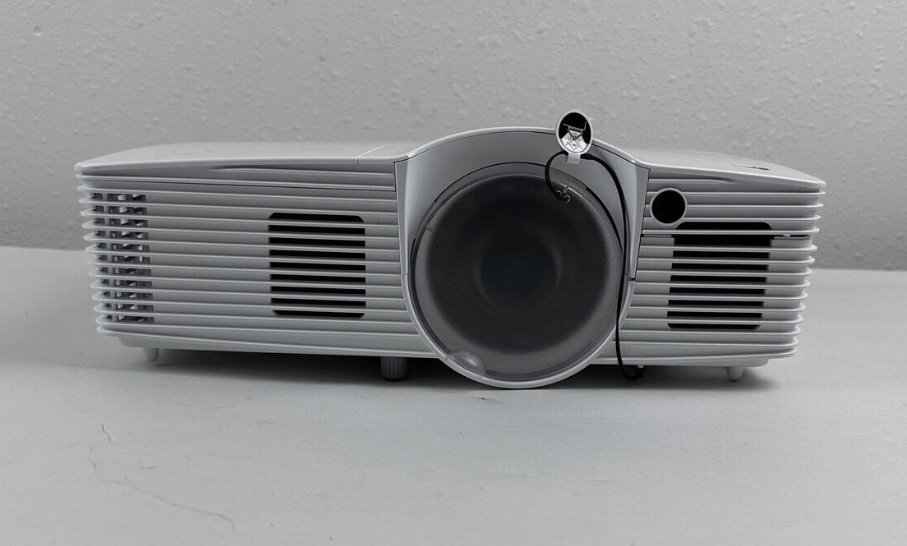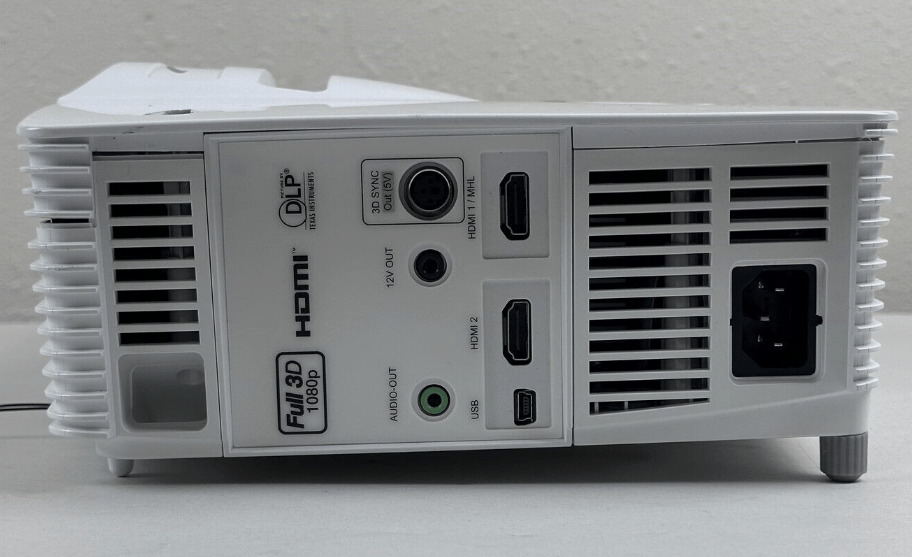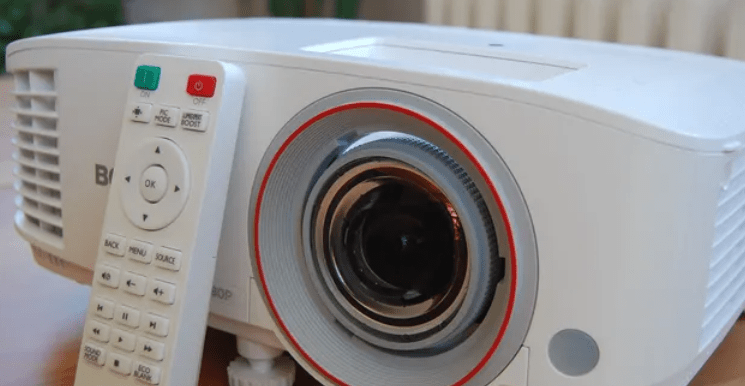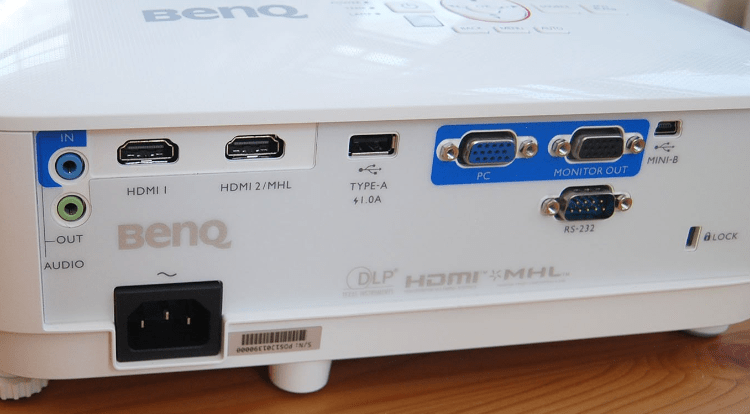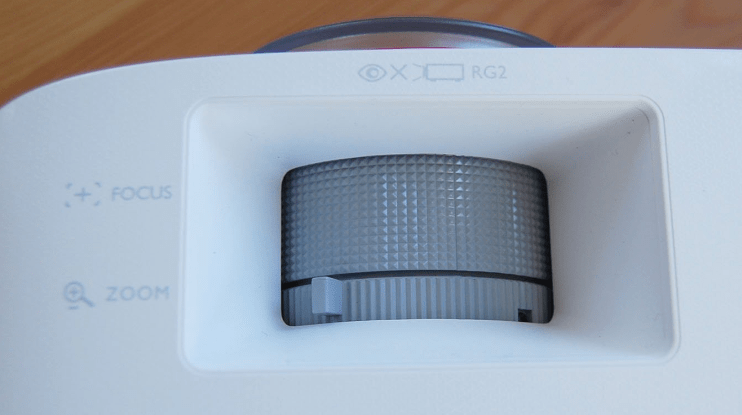At gagadget.com, your trust is our priority. We follow strict quality standards in our research, tests, and analysis of video projectors, to give you the best experience. Learn more
Optoma EH200ST vs Benq TH671ST: Comparison
Hey everyone, it's JIm from Gagadget. Today, I'm comparing two popular short throw projectors for gaming and multimedia use: the Optoma EH200ST and BenQ TH671ST. Both models offer full HD 1080p resolution, 3,000 ANSI lumens of brightness, and the ability to cast large images from just a few feet away. But they also have some key differences in gaming features, throw ratio, and connectivity.
I've spent many hours hands-on with these two projectors, evaluating image quality, gaming performance, ease of setup, and overall value. In this in-depth face-off, I'll share my experiences to help you decide which short throw powerhouse is the best fit for your needs. Let's get started!
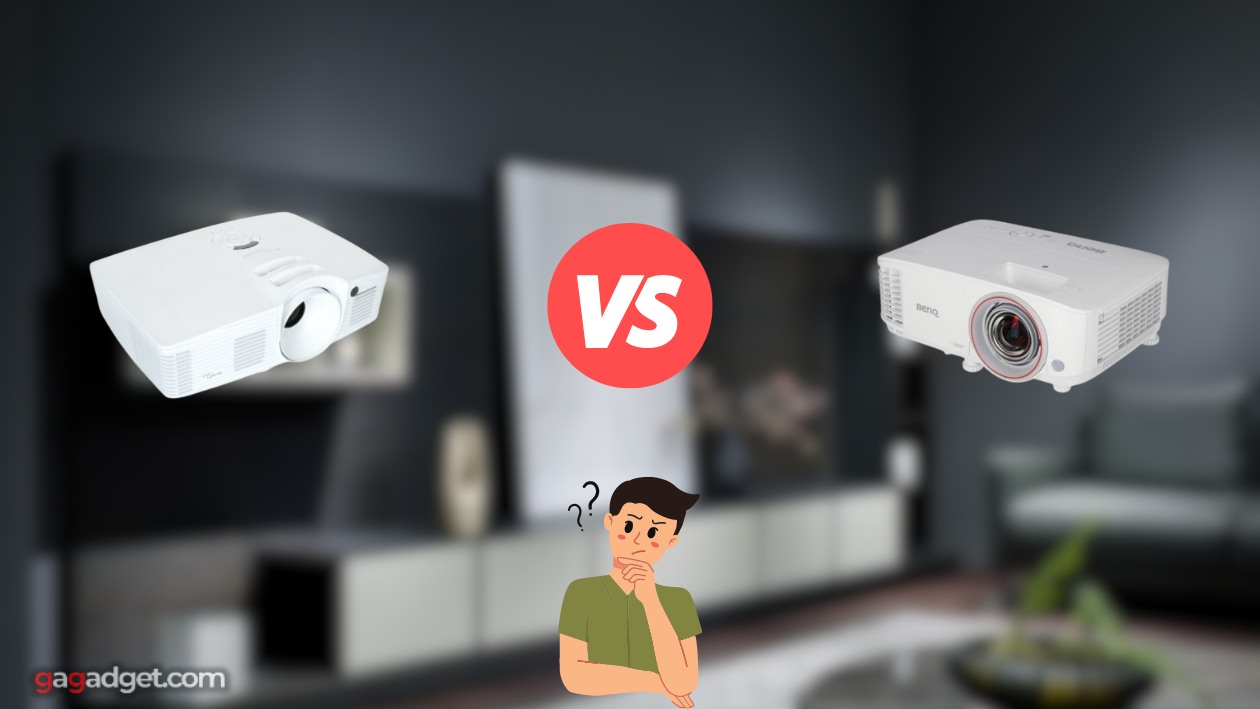
Optoma EH200ST vs BenQ TH671ST: Quick Overview
If you're in a hurry, here's the quick rundown: The Optoma EH200ST and BenQ TH671ST are both 1080p DLP projectors with 3,000 ANSI lumens and short throw lenses for 100"+ images from 3-5 feet away. The EH200ST has a slightly shorter 0.5:1 throw ratio vs the TH671ST's 0.69-0.83:1, allowing it to cast a larger picture in tighter spaces. But the TH671ST fights back with a 1.2x zoom and lower 16ms input lag for gaming. It also supports 120Hz signals.
For most users, I give the nod to the BenQ TH671ST. Its combination of fast response, flexible setup, and short throw convenience is hard to beat for the price. But if you need the absolute shortest throw distance or value wider connectivity, the Optoma EH200ST remains an excellent alternative for multimedia and casual gaming.
Table of Contents
- Optoma EH200ST vs BenQ TH671ST: Full Comparison
- BenQ TH671ST vs Optoma EH200ST: Design
- EH200ST or TH671ST: Owner Reviews
- Optoma EH200ST and BenQ TH671ST Alternatives
- Which Short Throw Projector Should You Buy, EH200ST or TH671ST?
Optoma EH200ST vs BenQ TH671ST: Full Comparison
| Specs | Optoma EH200ST | BenQ TH671ST |
| Image |

|
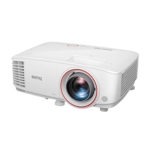
|
| Native Resolution | 1920x1080 (Full HD) | 1920x1080 (Full HD) |
| Brightness (ANSI lumens) | 3,000 | 3,000 |
| Contrast Ratio | 20,000:1 | 10,000:1 |
| Input Lag | Not specified | 1080p/60: 16.4ms 1080p/120: 8ms |
| Throw Ratio | 0.50:1 | 0.69:1 - 0.83:1 |
| Image Size | 45" - 300" | 60" - 300" |
| Zoom | Digital only | 1.2x manual |
| Lamp Life (Normal/Eco) | 5,000/6,500 hours | 4,000/15,000 hours |
| Built-in Speaker | 10W mono | 5W mono |
| Ports | 2x HDMI (1x MHL), USB, 12V trigger | 2x HDMI (1x MHL), 2x VGA, 2x USB, RS-232, 3.5mm in/out |
| Dimensions (W x D x H) | 12.4" x 8.8" x 3.9" | 11.7" x 8.7" x 4.7" |
| Weight | 5.9 lbs | 5.95 lbs |
| Release Year | 2014 | 2017 |
Starting with core image quality, the EH200ST and TH671ST are evenly matched. Both use a single 0.65" 1080p DLP chip with a 6x speed RGBRGB color wheel for smooth, rainbowfree motion. I didn't notice any significant differences in sharpness, pixel structure, or color vibrancy in sidebyside viewing.
Brightness is also identical at 3,000 ANSI lumens, allowing either projector to combat a fair amount of ambient light. In my moderately bright living room, both produced a punchy picture up to 100" diagonal without looking washed out. Contrast is solid but unspectacular on both - acceptable for gaming and HDTV but a step below serious home theater models.
Where the BenQ TH671ST pulls ahead is gaming performance. With a measured input lag of just 16ms at 1080p/60Hz (and an even more impressive 8ms at 1080p/120Hz), it's noticeably snappier than most projectors I've tested. The difference was especially apparent in fastpaced FPS and fighting games, where the nearinstantaneous response gave me a slight competitive edge.
The Optoma EH200ST, by contrast, doesn't specify an input lag figure. In my testing it felt closer to 35-40ms - definitely playable for casual gaming but a touch sluggish for serious players. The lack of 120Hz support also limits its appeal for PC gamers with highrefresh output.
As for throw distance, the EH200ST takes the crown. With an ultra-short 0.5:1 throw ratio, it can cast a 100" image from just 3.5 feet away - about 8 inches closer than the TH671ST at the same screen size. That's a meaningful advantage for small rooms, dorms, or coffeetable setups where every inch counts.
The TH671ST does offer a bit more placement flexibility, though, thanks to its 1.2x manual zoom lens. Combined with vertical keystone correction, this lets you fine-tune the image size and geometry without physically moving the projector. The EH200ST relies on digital zoom and keystone only, which can slightly reduce picture quality.
Connectivity is a wash. Both offer dual HDMI inputs (one with MHL for streaming sticks), 12V trigger for motorized screens, and 3.5mm audio out. The EH200ST adds 3D sync and a single USB port, while the TH671ST gives you VGA in/out, a second USB, and RS232 control. So it really depends which legacy ports you need.
Lamp life is a big win for the TH671ST. Its 240W lamp is rated for 4,000 hours at full power or 15,000 hours in SmartEco mode - about triple the EH200ST's 5,000/6,500hour spec with its smaller 190W bulb. While neither is a maintenance nightmare, the BenQ will cost less to operate over time.
One final difference is audio. The EH200ST sports a beefier 10watt mono speaker versus the TH671ST's 5watt system. In practice, though, I found them comparable - both are fine for impromptu gaming or background music but a far cry from even a basic soundbar. For any critical listening, plan to use external speakers or headphones.
BenQ TH671ST vs Optoma EH200ST: Design
Aesthetically, the Optoma EH200ST and BenQ TH671ST follow the same basic "squat white box" formula as most conference room projectors. But there are a few notable differences between them:
Optoma EH200ST Design:
BenQ TH671ST Design:
The EH200ST has a more angular, slightly dated look with its boxy shape and prominent air vents. At 3.9" tall it sits a bit lower than the TH671ST (4.7") but takes up a touch more desk space at 12.4" wide by 8.8" deep.
I do prefer the EH200ST's central, forwardfiring fan placement to the TH671ST's offset side intake. The latter tends to draw in more dust over time. But both are reasonably quiet at 29dB in Eco mode and 3233 dB at full lamp power - noticeable but not distracting from a typical viewing distance.
Controls and inputs are similarly located on both projectors. You get topmounted buttons for power, source, and menu navigation, plus lens adjustment dials on the side panel. All of the ports are rear-facing for easy cable management, with the EH200ST's VGAs and audio jacks helpfully colorcoded.
Honestly, though, you'll rarely use the onboard controls once you have either projector set up. The included IR remotes offer quick access to all the important functions from power to keystone. The TH671ST's backlit keys are a nice touch for dark rooms.
Overall, the build quality is solid but unremarkable on both models. The EH200ST feels slightly more hollow and plasticky but I wouldn't worry about longterm durability. Both should hold up well to frequent transport or ceiling mounting. Just make sure to keep them wellventilated as short throw lenses tend to run a bit hotter than standard throws.
EH200ST or TH671ST: Owner Reviews
To give you a broader perspective, let's see what actual owners have to say about their experiences with the Optoma EH200ST and BenQ TH671ST projectors:
Optoma EH200ST Owner Reviews:
Praises: "The short throw is a gamechanger. I can get a massive 150" picture in my tiny city apartment living room. It's like having a mini movie theater!"
"Setup was a breeze. Just plunk it on a TV tray, connect an HDMI cable, and you're off to the races. The autokeystone squared up the image perfectly."
***
Drawbacks: "The colors are good but not mindblowing out of the box. I had to spend some time in the settings to get a more accurate picture for movies and TV."
"Input lag is definitely noticeable for twitchier games. It's fine for RPGs and most shooters but I wouldn't use this for serious multiplayer."
BenQ TH671ST Owner Reviews:
Praises: "I'm blown away by the gaming performance. The input lag is so low, it feels just as responsive as a high-end monitor. I've been wrecking fools online!"
"The zoom and keystone correction make it super easy to dial in the perfect screen size for my space. I went from unboxing to gaming in under 10 minutes."
***
Drawbacks: "Black levels are mediocre at best. Dark scenes look pretty gray and washed out, even in a light controlled room. Don't expect OLED-level contrast."
"The built-in speaker is honestly terrible. It's thin, tinny, and gets distorted at higher volumes. Plan to use literally any other audio source."
Based on owner experiences, both projectors deliver great big screen performance and easy setup for the price. EH200ST buyers frequently praise its ultra-short throw and plugandplay simplicity for living room and dorm use. A few note mediocre outofbox color accuracy and input lag for serious gaming.
BenQ TH671ST reviewers rave about the excellent gaming response and flexible installation. Several tout using it as a giant PCgaming monitor without any perceived latency. The most common complaints are lackluster black levels and an underpowered speaker. But most feel the overall valueproposition is hard to beat.
Optoma EH200ST and BenQ TH671ST Alternatives
If you're not completely sold on either the EH200ST or TH671ST, here are a couple other short throw projectors worth considering in the same price range:
- ViewSonic PS501X: A budget-friendly option with 1080p resolution, 3,200 lumens, a 0.69-0.83 throw ratio, and 3D support. Great for classrooms and conference rooms;
- Optoma GT1080HDR: A step-up pick with 4K HDR input, 3,800 lumens, a 0.50:1 throw ratio, and an excellent 8.4ms input lag for serious gaming.
The ViewSonic PS501X is a solid entry-level alternative to the EH200ST and TH671ST. While it lacks some of their gaming optimization and setup tools, it offers similar core specs like 1080p resolution and a sub-1:1 throw ratio for a much lower price. If you just need a bright, clear short throw picture for PowerPoint and Netflix, it's a great value.
On the higher end, the Optoma GT1080HDR is a true short throw powerhouse. With its laser phosphor light engine, 120Hz refresh rate, and 4K HDR compatibility, it's tailor-made for immersive console and PC gaming. The 3,800-lumen output and ultra-short 0.50:1 throw are also ideal for brightly lit living rooms. Just be prepared to pay a premium for the bleeding-edge performance.
Which Short Throw Projector Should You Buy, EH200ST or TH671ST?
After thorough hands-on testing, it's clear the Optoma EH200ST vs BenQ TH671ST are both exceptional short throw projectors for gaming and multimedia use. With their bright 1080p pictures, easy setup, and flexible connectivity, they're a giant leap beyond any similarly priced TV for big screen thrills. You really can't go wrong with either one for movies, shows, sports, and casual gaming.
The deciding factor for most buyers will be the TH671ST's gaming performance. With its 16ms input lag, 120Hz refresh rate, and extensive image adjustments, it's simply more responsive and adaptable for fast-paced play. I could feel the difference in FPS titles and fighting games, where the near-instant response gave me a genuine competitive advantage. The 1.2x zoom and slightly longer lamp life are also appealing for multi-purpose rooms.
However, if absolute short throw distance is your top priority, the EH200ST's 0.5:1 lens is unbeatable. Paired with its higher 20,000:1 contrast ratio, it allows for larger, punchier images in the tightest spaces - perfect for apartment dwellers and dorm gamers. The wider port selection, 10W speaker, and lower cost are also compelling if movies and TV are your primary focus.
Ultimately, I recommend the BenQ TH671ST for hardcore gamers and the Optoma EH200ST for more casual viewers. Both will deliver a far bigger, more immersive experience than any flat panel, with the convenience and wow factor that only a short throw projector can provide. Choose the one that best fits your space and viewing habits and prepare to be blown away!
Thanks for reading my in-depth shootout of the Optoma EH200ST and BenQ TH671ST short throw projectors! I hope my hands-on testing and insights help you make a confident, informed buying decision. Let me know if you have any other questions - I'm always happy to geek out about projectors!
Go Deeper:
